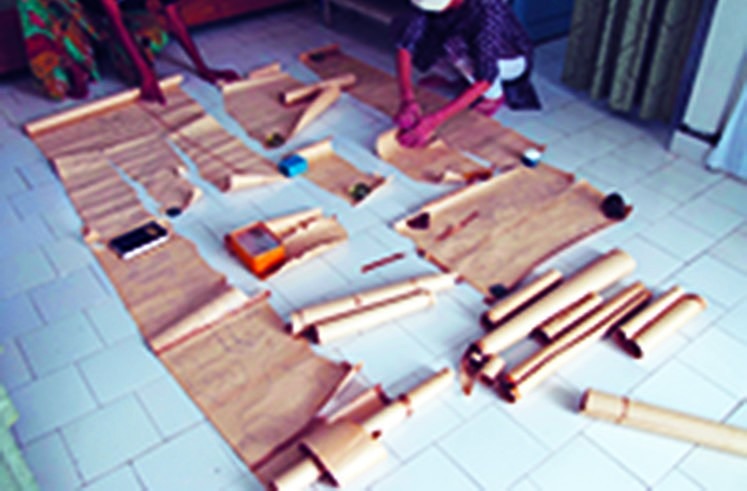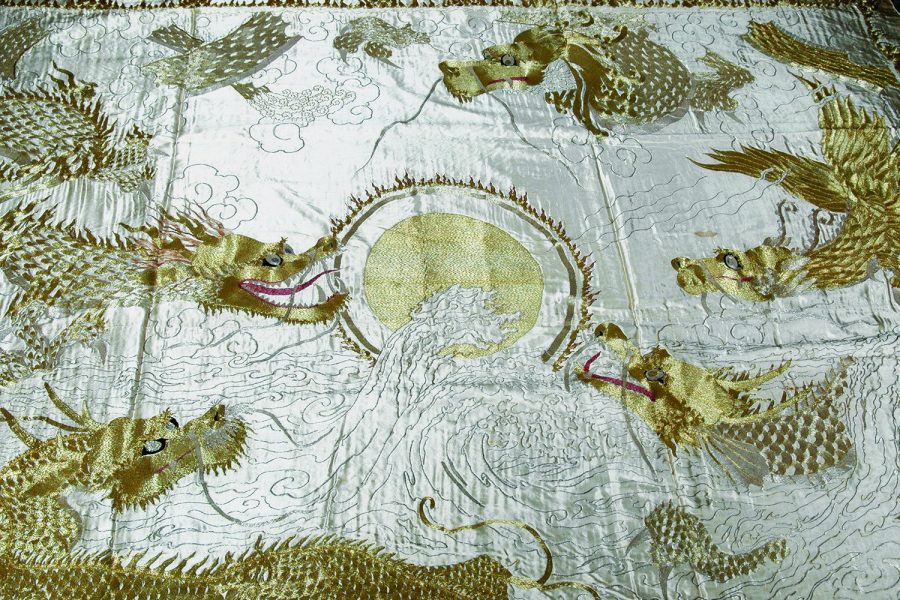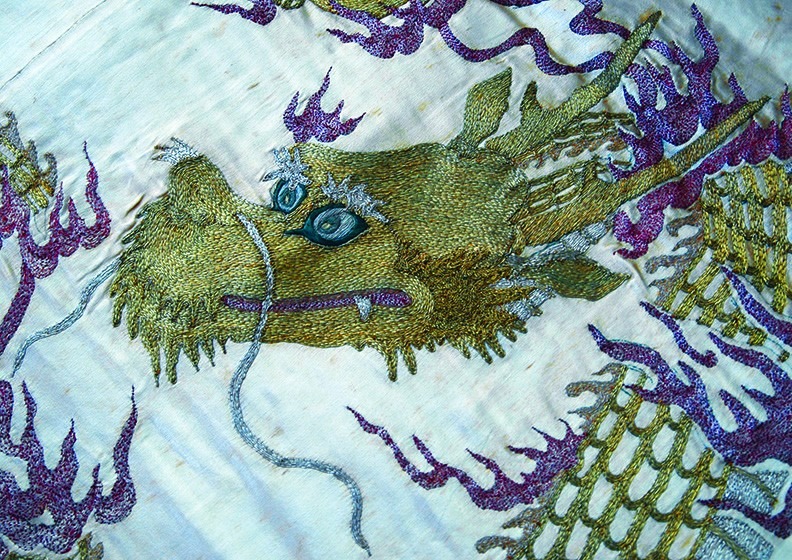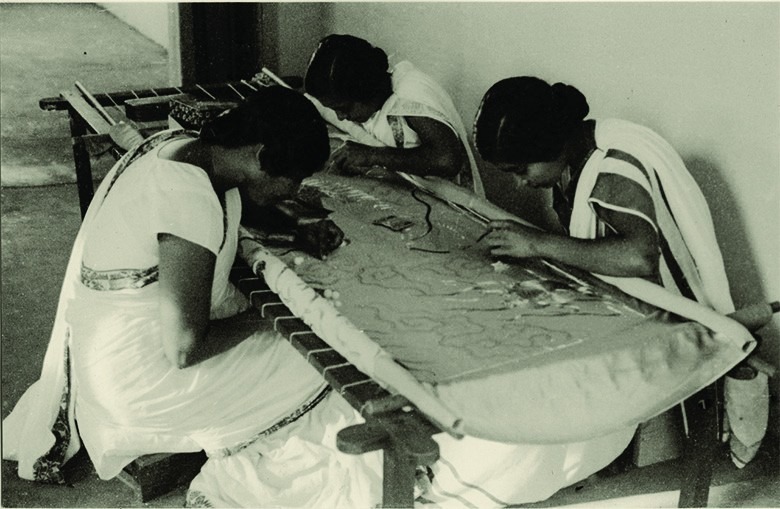Readers may recall that on the Siddhi Day, 24 November 1926, a black silk curtain with three dragons in gold was hung on the wall of the verandah for the evening meditation. The tail of one dragon reached up to the mouth of the other and the three of them covered the curtain from end to end.
B. Purani records in The Life of Sri Aurobindo that they came to know later about a Chinese prophecy that says the Truth will manifest itself on earth when the three dragons (representing the worlds of earth, mind, and sky) meet.
A World of Resplendent Dragons
In September 2007, the Embroidery Department asked the Archives Conservation Lab to help reorganise, repair, and rehouse its collection of patterns made for the Mother during the 1940s. Among these patterns, in particular, are seventeen sketches of dragons in various sizes. Drawn primarily in graphite and black India ink, most of the dragon patterns had been sketched on large sheets of brown packing paper. Without exception, they were in a poor condition, having spent years folded or rolled up in overstuffed trunks. The project to preserve these historical drawings took about seven years.
The dragon patterns were sketched by Sanjivan, one of the Ashram’s artists. The Mother gave him a small card with a drawing of a Chinese dragon and explained to him what she wanted, often indicating the colour. Sanjivan confidently drew the designs on large sheets of kraft paper on the floor of the corridor upstairs in the main Ashram building. The Mother occasionally passed by to observe what he was doing. The sinuous patterns were then traced onto silk or satin, and finally embroidered with silk thread or gold and silver zari by young Ashram sadhikas.((( Zari, or zari work as it is known, is an intricate art of weaving threads made of fine gold or silver. Those responsible for sewing the dragon embroideries were Vasudha, Tara, Monghi, Minou, Annasouya, Bela, Lila, and Nirmala.))) Sanjivan said that the Mother’s way of teaching was not just through practical guidance, but rather she could create with her advice the consciousness to understand and execute the work vividly and successfully.
We learned that the Mother commissioned this set of dragons for 15 August 1947 to celebrate Sri Aurobindo’s birthday and the independence of India.((( Taraben’s recollection, confirmed by the Embroidery Department and Gautam Chawalla.))) The embroideries were to adorn the walls, lintels and tables of Sri Aurobindo’s rooms. The meticulousness of these embroideries is astonishing, their beauty inspiring. When one looks at the dragons in their exquisite splendour, one feels they are playful. As one examines the superb skillfulness of this embroidery work, one perceives an act of love.

Pattern pieces being sorted

Pattern pieces in the humidification chamber

A dragon pattern before (above) and after mending
The conservation project began by placing the dragon patterns in a humidification chamber to allow the brittle paper to relax so it could be flattened under weights. Then each pattern was pieced together. Some were so fragmented it was a challenge to match the correct snout or claw with the right dragon.
Each fragment was cleaned with finely grated Staedtler eraser crumbs and a soft brush. Then the pieces were joined together with small “band-aids” of Japanese paper and wheat starch paste or methyl cellulose adhesive. Once assembled, the pattern was supported with larger strips of Japanese paper on both sides. Lining was not an option because the moisture it introduces was found to alter the colour of the inks and the paper. Heat-set mending tissue, activated with heat, did not adhere well because of ingrained soiling of the paper.
When the mending was completed, each pattern was interleafed with imported acid-free buffered interleafing paper and rolled onto a long tube for support. The roll storage tubes for this project are made from unbleached kraft fibers, have a neutral pH and are generally used to store photographic paper. A layer of acid-free buffered paper((( Made from 100% cotton rag at the Ashram Handmade Paper Factory.))) was wrapped around the tube before rolling up the pattern, then covered with a soft muslin cloth and finally a thicker cloth for additional protection against dust and abrasion. A tracing of the pattern and a treatment report were stored inside the center of the tube.((( Tracing the dragon patterns was so absorbing that we developed a kind of “dragon fever” whereby we couldn’t wait to begin each sitting and eagerly looked forward to the next. Dominant was the quiet atmosphere and a deep satisfaction after the completion of each dragon. Those involved in the tracing, which took about three years, were Maya, Mallika, Vilas, Barbie, Bimla, Mahesh, Koki and Nomi.))) The patterns are presently housed in the Ashram cold storage room for long-term preservation.
One of the first dragons to be completed was a wall hanging for Sri Aurobindo’s room. The pattern portrays five dragons which represent the five elements: earth, water, fire, ether, and air. In a letter to a friend written in 1943, Sanjivan referred to this piece. “I was busy,” he wrote, “with the design of a 6’ x 8’ curtain. The subject was five dragons with the sun at the centre and a border of flames along the upper three sides. I finished the design at around 2:30 at night and gave it to the Mother this morning. The Mother very happily said that she will get this ‘magnificent design’ embroidered with silver and gold threads.”((( A copy of this letter was printed in Srinvantu (date and issue unknown).)))
 The five dragons pattern representing the five elements embroidered
The five dragons pattern representing the five elements embroidered
with gold and silver zari on satin
The design was embroidered by Vasudha, utilising a stitch called “couching” or laid stitching which involves two sets of threads, the set that is being laid onto the surface of the fabric and the set that attaches the laid threads. As pure gold thread from Surat was used, each dragon is seen in a scintillating aura of gilded glory. “Magnificent it was, when the work was finished!” exclaimed Sanjivan.((( Bela-di mentioned that silver and red threads were used to make the flames, silver thread to make the clouds, and gold thread to make the dragons.))) This piece, as well as a few others, formed “the dragon’s corner” at the Exhibition of Embroideries, Laces and Fans displayed at the Ashram Exhibition Hall from February 20 to 23, 1956. In her book The Story of a Soul, Huta recollected: “I was really fascinated seeing an incredible set of six pieces made of heavy white satin — the enormous dragons designed by Sanjivan had been embroidered in gold and silver thread by Vasudha and other sadhikas for the Mother’s couch and its accessories. In China the dragon is considered to be Spiritual Strength.… The Mother had sat on the couch only once — for a while on the Independence Day of India, 15th August 1947. This was ultra symbolic, for she embodied the true soul of our country — Mother India.”((( Huta. The Story of a Soul, Vol. 2, Part 1 (Pondicherry: The Havyavahana Trust, 2009) p.50.)))
A sadhika recollected that Mother gave them only one month to complete the set. They worked day and night, resting and taking just a bit to eat in between. Once when they were feeling tired and the work slowed down, Mother came and sat down among them and told them that they must make friends with the thread. “Years ago”, another narrated, “we used to embroider the bedcovers and curtains for Mother and Sri Aurobindo in the room which is now the Bulletin Office. We sat on the floor around a wooden frame onto which the cloth was stretched for embroidering. There was no fixed time; we worked for hours. We had no watches to distract us. The Mother used to come down to this room with a tray of glasses filled with juice. She would smile and say, ‘Put your needles down, mes petites, and relax your eyes. They need rest.’ Then we would drink the juice brought by our Sweet Mother while she appreciated our work; sometimes she even guided us.”((( Taraben’s recollection, as recounted by Sunandaben and others.)))
Sadhikas at work on an embroidery frame
Contemplating this collection, one is struck with wonder at its beauty. The skill and devotion with which the embroideries were done makes them unique masterpieces. Like the patterns, the seventeen dragon embroideries have been carefully interleafed and individually rehoused for long-term storage. When Sanjivan first saw one of the embroidered dragons, he commented to a friend that it had been “done so well, it had such a gorgeous look”; it was “a piece worth showing to the whole world”.
Archives Conservation Lab
Note: Our gratitude to Vilas for her remarkable skill in providing information from innumerable sources.
Excerpt from SABDA Newsletter 2018.12










About Savitri | B1C1-09 Advent of the Divine Mother (p.4)